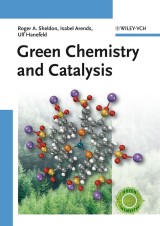Details

Green Chemistry and Catalysis
1. Aufl.
|
183,99 € |
|
| Verlag: | Wiley-VCH |
| Format: | |
| Veröffentl.: | 27.06.2007 |
| ISBN/EAN: | 9783527611010 |
| Sprache: | englisch |
| Anzahl Seiten: | 448 |
DRM-geschütztes eBook, Sie benötigen z.B. Adobe Digital Editions und eine Adobe ID zum Lesen.
Beschreibungen
This first book to focus on catalytic processes from the viewpoint of green chemistry presents every important aspect:<br> <br> ? Numerous catalytic reductions and oxidations methods<br> ? Solid-acid and solid-base catalysis<br> ? C-C bond formation reactions<br> ? Biocatalysis<br> ? Asymmetric catalysis<br> ? Novel reaction media like e.g. ionic liquids, supercritical CO2<br> ? Renewable raw materials<br> <br> Written by Roger A. Sheldon -- without doubt one of the leaders in the field with much experience in academia and industry -- and his co-workers, the result is a unified whole, an indispensable source for every scientist looking to improve catalytic reactions, whether in the college or company lab.
INTRODUCTION: GREEN CHEMISTRY AND CATALYSIS<br> E Factors and Atom Efficiency<br> The Role of Catalysis<br> The Development of Organic Synthesis<br> Catalysis by Solid Acids and Bases<br> Catalytic Reduction<br> Catalytic Oxidation<br> Catalytic C-C Bond Formation<br> The Question of Solvents: Alternative Reaction Media<br> Biocatalysis<br> Renewable Raw Materials and White Biotechnology<br> Enantioselective Catalysis<br> Risky Reagents<br> Process Integration and Catalytic Cascades<br> SOLID ACIDS AND BASES AS CATALYSTS<br> Solid Acid Catalysis<br> Solid Base Catalysis<br> Other Approaches<br> CATALYTIC REDUCTIONS<br> Heterogeneous Reduction Catalysts<br> Homogeneous Reduction Catalysts<br> Biocatalytic Reductions<br> CATALYTIC OXIDATIONS<br> Mechanisms of Metal-catalyzed Oxidations<br> Alkenes<br> Alkanes and Alkylaromatics<br> Oxygen-containing Compounds<br> Heteroatom Oxidation<br> Asymmetric Oxidation<br> CATALYTIC CARBON-CARBON BOND FORMATION<br> Enzymes for Carbon-Carbon Bond Formation<br> Transition Metal Catalysis<br> HYDROLYSIS<br> Hydrolysis of Esters<br> Hydrolysis of Amides<br> Hydrolysis of Nitriles<br> CATALYSIS IN NOVEL REACTION MEDIA<br> Two Immiscible Organic Solvents<br> Aqueous Biphasic Catalysis<br> Fluorous Biphasic Catalysis<br> Supercritical Carbon Dioxide<br> Ionic Liquids<br> Biphasic Systems with Supercritical Carbon Dioxide<br> Thermoregulated Biphasic Catalysis<br> CHEMICALS FROM RENEWABLE RAW MATERIALS<br> Carbohydrates<br> Chemical and Chemoenzymatic Transformations of Carbohydrates into Fine Chemicals and Chiral Building Blocks<br> Fats and Oils<br> Terpenes<br> Renewable Raw Materials as Catalysts<br> Green Polymers from Renewable Raw Materials<br> PROCESS INTEGRATION AND CASCADE CATALYSIS<br> Dynamic Kinetic Resolutions by Enzymes Coupled with Metal Catalysts<br> Combination of Asymmetric Hydrogenation with Enzymatic Hydrolysis<br> Catalyst Recovery and Recycling<br> Immobilization of Enzymes<br> EPILOGUE: FUTURE OUTLOOK<br> Green Chemistry: The Road to Sustainability<br> Catalysis and Green Chemistry<br> The Medium is the Message<br> Metabolic Engineering and Cascade Catalysis<br>
"...The book is very well referenced and illustrated and its layout is very well thought out and executed. It makes clear that catalysis, the bedrock of the petrochemical industry, will play an equally crucial role in the invention and reinvention of green processes."<br> Chemsitry World, 08/2007<br> <br> "...The book is very well referenced and illustrated and its layout is very well thought out and executed."<br> Chemistry World, August 2007
All three authors are currently employed at the TU Delft. Their research is directed towards the development of atom-efficient, low-waste processes for the synthesis of high added value chemicals, such as pharmaceuticals and chiral intermediates. Within the framework of green chemistry the aim is to respond to the public need towards the 12 principles of green chemistry
The expression "Green Chemistry" is used to describe chemical processes that take into consideration sustainable development and environmentally improved products, as well as other aspects to make the reaction "cleaner". In recent years, this principle has become very important, with "Green Catalysis" a major topic within this field.<br> Written by Roger A. Sheldon and his co-workers, this first book to focus on catalytic processes from the viewpoint of green chemistry presents every important aspect:<br> <br> - Numerous catalytic reductions and oxidations methods<br> - Solid-acid and solid-base catalysis<br> - C-C bond formation reactions<br> - Biocatalysis<br> - Asymmetric catalysis<br> - Novel reaction media like e.g. ionic liquids, supercritical CO2<br> - Renewable raw materials.<br> <br> The result is a unified, indispensable source for all scientists looking to improve their catalytic reactions, whether in the college or company lab.

















